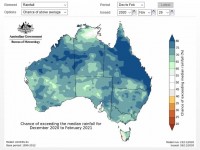
Australia can expect a wetter than normal summer, but bush and grass fires cannot be ruled out completely, according to the Bureau of Meteorology’s Summer Climate Outlook released today.
The outlook for summer has been issued as Australia continues to experience an active La Niña event which is expected to remain until at least the start of autumn.
The Bureau’s Head of Operational Climate Services Dr Andrew Watkins said this means large parts of eastern Australia have an increased risk of flooding.
“While the last three weeks have been dry in many parts of the country – due in part to unfavourable tropical weather patterns – it does not signal a weakening of La Niña.
“Our climate outlook is the opposite of what we experienced last year in Australia. This summer, New South Wales, Victoria and Queensland are expected to see above average rainfall, meaning we face an increased risk of widespread floods.
Dr Watkins said that while the risk of bushfires isn’t as high as last summer, fires will occur.
“There’s a great chance of grass fires in some areas as recent rain and warm weather have led to vigorous vegetation growth. South eastern Australia is one of the most fire-prone regions in the world. Even short periods of hot and dry weather increase the risk of fire in summer.”
Dr Watkins said the outlook was also a reminder for communities to be prepared for heatwaves over the coming months.
“Every summer we see heatwaves across southern Australia. This summer heatwaves may not reach the extreme temperatures of recent years, but may be longer duration and more humid, which can still have a significant impact on human health.
“Daytime temperatures in summer are likely to be near average, but there will be periods of high heat combined with milder periods.
“It’s important to keep up to date with the .”
Dr Watkins said Northern Australia remains on track for an average to slightly above average cyclone season.
“On average, Australia sees 9 to 11 tropical cyclones each year, with 4 crossing the coast. The first cyclone to develop in the Australian region occurs earlier during La Niña years.
“People in the north of the country should prepare for tropical cyclones now. And don’t forget tropical lows, which can bring heavy rainfall, flooding and cause significant property damage.”








